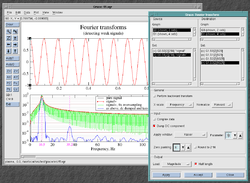Grace (plotting tool)
Grace is a free WYSIWYG 2D graph plotting tool, for Unix-like operating systems. The package name stands for "GRaphing, Advanced Computation and Exploration of data." Grace uses the X Window System and Motif for its GUI. It has been ported to VMS, OS/2, and Windows 9*/NT/2000/XP (on Cygwin). In 1996, Linux Journal described Xmgr (an early name for Grace) as one of the two most prominent graphing packages for Linux.[1]
 Preview of Grace-6, showing the Fourier transform dialogue | |
| Original author(s) | Paul Turner (Xmgr) Evgeny Stambulchik (Grace) |
|---|---|
| Developer(s) | Grace Development Team |
| Initial release | 1991 (Xmgr) 1998 (Grace) |
| Stable release | 5.1.25
/ 14 February 2015 |
| Preview release | 5.99.1dev5
/ 7 May 2007 |
| Written in | C |
| Operating system | Any Unix-like |
| Available in | English |
| Type | Plotting |
| License | GPL |
| Website | plasma-gate |
History
Grace is a descendant of the ACE/gr plotting tool (also known as Xvgr), based on Xview libraries from OpenWindows.[2] Xvgr was originally written by Paul Turner of Portland, Oregon,[3] who continued development until version 4.00.[4] In 1996, development was taken over by the ACE/gr development team, led by Evgeny Stambulchik at the Weizmann Institute of Science, Israel.[5][6] Development of Xmgr was frozen at version 4.1.2 in 1998[3] and the Grace project was started as a fork, released under the GPL.[7] The name stands for "GRaphing, Advanced Computation and Exploration of data" or "Grace Revamps ACE/gr"[6] Turner still maintains a non-public version of Xmgr for internal use.[6] The first version of Grace was numbered 5.0.0 and the latest stable version, 5.1.25 (released February 2015).[2] Whether the development of the next major release 6.0.0 is still in progress is unclear. The latest preview versions numbered 5.99.* were released in 2007.[8]
Currently maintained versions
Noteworthy alternate versions of Grace include GraceGTK, forked from Grace 5.1.22 in 2009 by Patrick Vincent,[9] and QtGrace, released in 2011 by Andreas Winter. [10] Both of these versions of Grace work natively on Windows operating systems and had releases in 2017.
Features
Grace can be used from a point-and-click interface or scripted (using either the built-in programming language or a number of language bindings). It performs both linear and nonlinear least-squares fitting to arbitrarily complex user-defined functions, with or without constraints. Other analysis tools include FFT, integration and differentiation, splines, interpolation, and smoothing.[11]
Programs using Grace
- GROMACS
- MOLPRO
- NAMD
- Visual Molecular Dynamics
- AptPlot
See also
- List of graphing software
References
- Vaught, Andy (1 August 1996), "Graphing with Gnuplot and Xmgr", Linux Journal, retrieved 19 June 2009
- Stambulchik, Evgeny (1998–2000), Grace, retrieved 20 June 2009
- Stambulchik, Evgeny (1997), Xmgr, retrieved 20 June 2009
- Paul J Turner and ACE/gr development team (13 May 1998), Xmgr: List of changes, retrieved 20 June 2009
- ACE/gr development team (10 May 1998), Xmgr user guide: introduction, retrieved 20 June 2009
- Grace development team (20 September 2008), Grace user guide: "What is Grace?", retrieved 20 June 2009
- Grace development team (21 May 2008), Grace copyright notice, retrieved 20 June 2009
- Grace development team (8 May 2006), Grace-6 Roadmap, retrieved 20 June 2009
- GraceGTK development team (25 May 2018), GraceGTK, Sourceforge, retrieved 2 July 2018
- Winter, Andreas. "QtGrace". Retrieved 14 November 2018.
- "Grace at NERSC". NERSC. Archived from the original on 24 February 2013. Retrieved 15 February 2013.